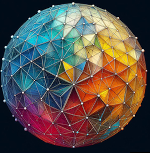A triple ratio on the Silov boundary of a bounded symmetric domain
Atti della Accademia nazionale dei Lincei. Rendiconti Lincei. Matematica e applicazioni, Série 9, Tome 13 (2002) no. 3-4, pp. 209-217.
Voir la notice de l'article dans Biblioteca Digitale Italiana di Matematica
Let $D$ be a Hermitian symmetric space of tube type, $S$ its Silov boundary and $G$ the neutral component of the group of bi-holomorphic diffeomorphisms of $D$. Our main interest is in studying the action of $G$ on $S^{3} = S \times S \times S$. Sections 1 and 2 are part of a joint work with B. Ørsted (see [4]). In Section 1, as a pedagogical introduction, we study the case where $D$ is the unit disc and $S$ is the circle. This is a fairly elementary and explicit case, where one can easily get a flavour of the more general results. In Section 2, we study the case of tube type domains, for which we show that there is a finite number of open $G$-orbits in $S^{3}$, and to each orbit we associate an integer, called the Maslov index. In the special case where $D$ is the Siegel disc, then $G$ is (isomorphic to) the symplectic group and $S$ is the manifold of Lagrangian subspaces. The result on the orbits and the number which we construct coincides with the classical theory of the Maslov index (see e.g. [7]), hence the name. We describe a formula for computing the Maslov index, using the automorphy kernel of the domain $D$. In the special case of the Lagrangian manifold, this formula was obtained by Magneron [8] in a different approach. In Section 3, we study the case where $D$ is the unit ball in a (rectangular) matrix space. There is now an infinite family of orbits, and we construct characteristic invariants for the action of $G$ on $S^{3}$. For the special case where $D$ is the unit ball in $\mathbb{C}^{2}$, this coincides with an invariant constructed by E. Cartan for the «hypersphere» (see [2]). In all cases, we follow the following method: from an appropriate automorphy kernel for $D$ we construct a kernel on $D \times D \times D$, satisfying a simple transformation property under the action of $G$. We then define a dense open set of $S^{3}$ (the set of mutually transversal points in $S$), on which the kernel (or some function of it) can be extended continuously, and the resulting kernel is invariant or at least transforms nicely under the action of $G$.
@article{AANLMA_2002_9_13_3-4_a3,
author = {Jean-Louis, Clerc},
title = {A triple ratio on the {Silov} boundary of a bounded symmetric domain},
journal = {Atti della Accademia nazionale dei Lincei. Rendiconti Lincei. Matematica e applicazioni},
pages = {209--217},
publisher = {mathdoc},
volume = {Ser. 9, 13},
number = {3-4},
year = {2002},
language = {it},
url = {https://geodesic-test.mathdoc.fr/item/AANLMA_2002_9_13_3-4_a3/}
}
TY - JOUR AU - Jean-Louis, Clerc TI - A triple ratio on the Silov boundary of a bounded symmetric domain JO - Atti della Accademia nazionale dei Lincei. Rendiconti Lincei. Matematica e applicazioni PY - 2002 SP - 209 EP - 217 VL - 13 IS - 3-4 PB - mathdoc UR - https://geodesic-test.mathdoc.fr/item/AANLMA_2002_9_13_3-4_a3/ LA - it ID - AANLMA_2002_9_13_3-4_a3 ER -
%0 Journal Article %A Jean-Louis, Clerc %T A triple ratio on the Silov boundary of a bounded symmetric domain %J Atti della Accademia nazionale dei Lincei. Rendiconti Lincei. Matematica e applicazioni %D 2002 %P 209-217 %V 13 %N 3-4 %I mathdoc %U https://geodesic-test.mathdoc.fr/item/AANLMA_2002_9_13_3-4_a3/ %G it %F AANLMA_2002_9_13_3-4_a3
Jean-Louis, Clerc. A triple ratio on the Silov boundary of a bounded symmetric domain. Atti della Accademia nazionale dei Lincei. Rendiconti Lincei. Matematica e applicazioni, Série 9, Tome 13 (2002) no. 3-4, pp. 209-217. https://geodesic-test.mathdoc.fr/item/AANLMA_2002_9_13_3-4_a3/

